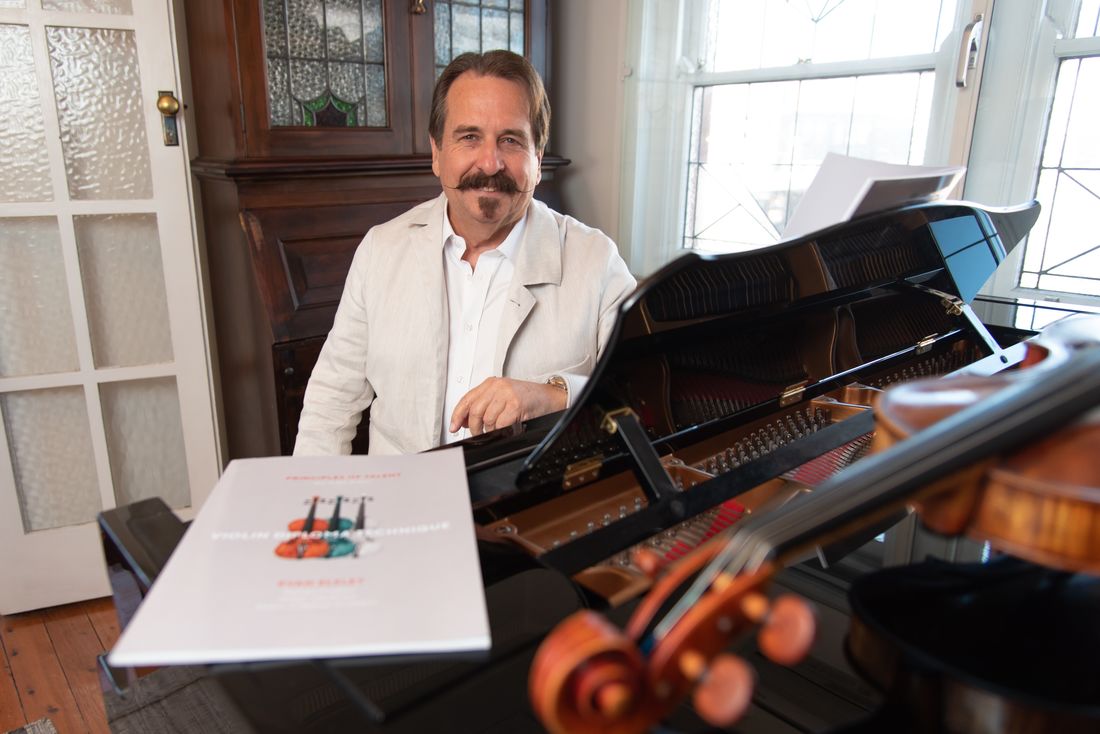| THE ENIGMA OF TALENT "All technical requirements must be captured, they do not, however, need to be captured in the most difficult way possible!" TWO FREE SAMPLES OF TALENT: Experience how using natural sensations captures the same technical intention with greater ease and security than using the uncomfortable sensations:
Traditional teaching transmits technique through demonstration, repetition, methods, exercises, and repertoire, relying on the student to intuit the final layers of technical security, including advanced co-ordination, and intonation. This works well for a minority but leaves many advanced students plateauing. "Principles of Talent" addresses this gap. The book defines the mechanics that expert players do naturally. An anecdotal example of this was when a well known violinist became a Conservatorium professor. He told me that he did not know how to teach, so he watched himself in the mirror, to see what he did. Technical talent is the felt perception of ease. This is why some violinists have the ability to capture rapid technical progress, without understanding how they do it. |  |
HISTORY OF TECHNICAL TALENT
Violin technique is not a straight line development that can be captured by practice alone. At different periods, the great violin virtuosi have created totally different types of technical repertoire:
- In all periods, intonation and co-ordination security are essential techniques. This requires the talent of active listening.
- In late Classicism, the violin bow transitioned to the modern design. This requires players to assimilate the bow's weight, balance, muscle groups, air pressure, and string crossing use of gravity.
- In early Romanticism, fast passages require sport techniques that control changes in directional momentum.
- In late Romanticism and C20th, the techniques of logistical analysis and individual invention are required.
The use of invention, causal logic, and sensations are often unexplored technical disciplines in the exam room. The same as practicing a scale with a different bowing, students can similarly practice their repertoire with the inclusion of easy sensations and thinking.
| Virtuosic level intonation and co-ordination are the biggest technical problems for the majority of candidates. This is solved by using the logic of a timeline. Every technique takes time. Once all known techniques are placed into a logically ordered timeline, it becomes apparent that there are moments of time, that are empty of mainstream teaching knowledge. These missing moments are the enigma of intonation and co-ordination. From the context of a timeline, however, they can be identified, and taught. This timeline creates a thought process, that becomes the foundation of all violin technique. | The ability to capture virtuosic speed then comes from applying many of the same techniques that are used in sport, and dance. These include techniques such as muscle groups, preparation concepts, postural security, and physical invention. Bowing techniques, especially when string crossing, use the forces of nature. These include air pressure, balance points, and gravity. The next stage is invention. | Defining these intuitive techniques of talent, fully reveals the co-ordinated moment, and intonation security.
When the mind uses the technique of a timeline, it has a foundation upon which it can then add the other abilities of talent. For diploma levels, all necessary technical talent can be explained and defined by causal logic. My book explains these new techniques in explicit detail, both mentally and physically. Musical interpretation then occurs during the timeline moment, of the bow's follow through. |
小提琴才能研究
- 你被告知要听,但不知道如何做?
- 你被告知要按调弦演奏,但不知道如何做?
- 你被告知要协调,但不知道如何做?
- 你从一个老师那里转到另一个老师那里吗?
- 你练习却没有进步吗?
尽管勤奋练习,并接受了大师教师的指导,成功并不总是确保的。传统的教学方法,对一些人有效,但往往无法为大多数人带来广泛的成功。从历史上看,在满足大多数候选人的学习需求方面,教授文凭级别技术的“如何做”通常过于模糊。时间轴定义了技术才能的详细科学。没有奇迹,只有魔法。
La recherche sur le talent de jeu en violon
- Êtes-vous invité à écouter, mais ne comprenez pas comment?
- Êtes-vous invité à jouer juste, mais ne comprenez pas comment?
- Êtes-vous invité à coordonner, mais ne comprenez pas comment?
- Passez-vous d'un professeur à un autre?
- Pratiquez-vous sans progresser?
Malgré une pratique assidue et des instructions de maîtres enseignants, le succès n'est pas toujours garanti. Les méthodes pédagogiques traditionnelles, efficaces pour certains, échouent souvent à se traduire par un succès généralisé pour beaucoup. Historiquement, l'enseignement du "comment faire" des techniques de niveau diplôme a été trop vague dans les détails, ne répondant pas aux besoins d'apprentissage de la plupart des candidats.
Une chronologie définit la science détaillée du talent technique. Il n'y a plus des miracles, juste de la magie.
Studia talentu gry na skrzypcach
- Czy ci mówią, żebyś słuchał, ale nie wiesz, jak?
- Czy ci mówią, żebyś grał czysto, ale nie wiesz, jak?
- Czy ci mówią, żebyś koordynował, ale nie wiesz, jak?
- Czy chodzisz od jednego nauczyciela do drugiego?
- Czy ćwiczysz bez postępów?
Mimo pilnej praktyki i instrukcji od mistrzów nauczycieli, sukces nie jest zawsze gwarantowany. Tradycyjne metody pedagogiczne, skuteczne dla niektórych, często nie przekładają się na powszechny sukces. Historycznie, nauczanie "jak robić" techniki na poziomie dyplomowym są zbyt mgliste w szczegółach, nie spełniając potrzeb nauki dla większości kandydatów.
Wykres lini czasu uczy jak osiągnąć talent techniczny. Nie potrzebujesz już cudów, znasz magie.